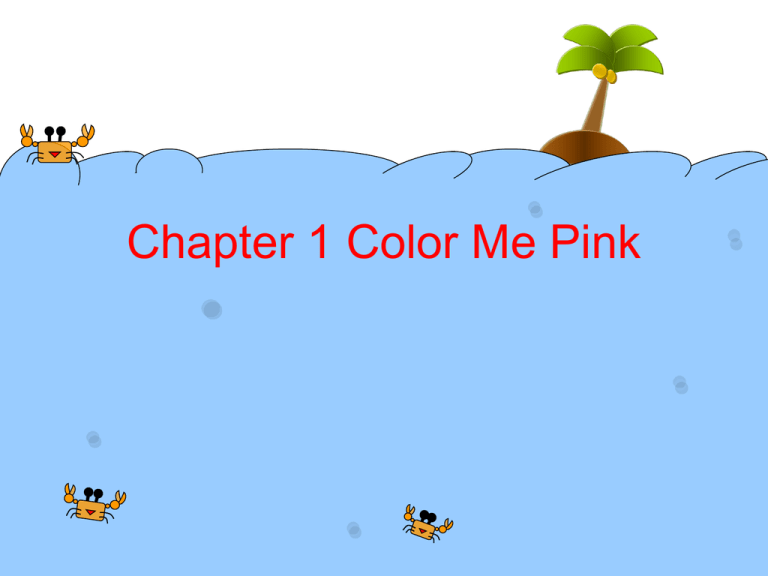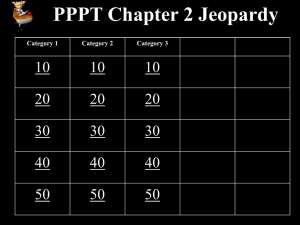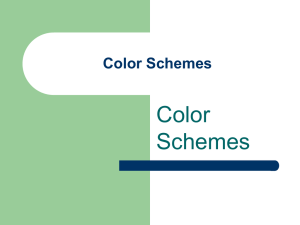Chapter 1 Color Me Pink
advertisement

Chapter 1 Color Me Pink Reading Warm Up • Stand up. • Find people who are wearing the same color as you. Form a group with them. • Find a place to sit. • Discuss how the color you are wearing today make you feel. • Show your opinion with the whole class. Pre-reading Activity • p. 2 Discuss these questions. 1. Imagine yourself as the person in the picture. How would you feel if the room were all blue? 2. How would you feel if the room were all red? 3. How would you feel if the room were all black? 4. What color would you like this room be? Why? Predicting p. 2 1. Match each color with a feeling. 1. _____ blue a. energy 2. _____ red b. kindness 3. _____ green c. wealth 4. _____ yellow d. courage 5. _____ brown e. sadness 6. _____ pink f. peace 2. Read through the passage on pages 3 and 4 to find out the answer. (3 minutes) 3. Compare your answers with your partners. Answer 4. Check your answers. 1. _____ e blue a. energy 2. _____ a red b. kindness 3. _____ green f c. wealth 4. _____ d yellow d. courage 5. _____ c brown e. sadness 6. _____ b pink f. peace Reading Activity pp. 3-4 • Work as a group. • Each group works on one paragraph. • Use your dictionary to check new words. • Discuss the main idea of the paragraph. • Prepare to answer the teacher’s questions. Group 1 (p. 3, pa. 1) Group 2 (p. 3, pa. 2) Group 3 (p. 3, pa. 3) Group 4 (p. 3, pa. 3) Explain this sentence, “We are all sensitive to color.” Q: What do the colors say about us? Give examples to the statement, “Our clothes send messages to others about our mood, personality and desires.” Group 5 (p. 3, pa. 4) Group 6 (p. 3, pa. 5) Group 7 (p. 3, pa. 5) Give examples to the statement, “Colors have always been used to describe not only our feelings but also our physical health and attitudes.” Give examples to the statement, “Color is used symbolically in all cultures, and it plays an important role in ceremonies and festivities.” Group 8 (p. 4, pa. 2) Group 9 (p. 3, pa. 3) Group 10 (p. 4, pa. 3) Q: What effects do colors have on people? Q: Describe how people can use colors to heal themselves. Q: Give examples of colors that can be used to heal people. Group 11 (p. 4, pa. 4) Group 12 (p. 4, pa. 5) Q: What is the Luscher color test? Q: What can colors do for us? Vocabulary • p. 5 Meaning 1. Complete each definition with one of the words in the list. Use your dictionary to look up new words. 2. Check your answers with your partners. Answer 1. 2. 3. 4. 5. 6. 7. 8. ailments soothe stimulating subconsciously coincidence attitude contentment Pace Vocabulary • pp. 5-6 Word Building Complete the sentences with the correct form of the word in capital letters. e.g. n. 1. SYMBOL symbolizes v. a. The color red _________ anger. symbolically b. Colors are used _________ to express feelings. adv. 2. n. EMOTION emotionally adv. a. People react _________ to different colors. b. You can express your _________ by wearing emotions n. different colors. 3. n. PSYCHOLOGY a. Some _________ use color to treat patients. psychologists n. b. Colors can help people with psychological _________ problems. adj. Comprehension • pp. 6-8 Looking for the Main Ideas 1. Learning about color can help us to ________. c. understand ourselves and others 2. Colors ________. c. say something about our personality 3. Some experts believe that ________. a. colors can be used to heal • Looking for Details 1. What do colorgenics experts say about a person who likes to wear pink? A person who likes to wear pink is warm and understanding. What does white symbolize in many cultures? White symbolizes purity in many cultures. What is yellow a symbol of in Peru? Yellow is a symbol of luck in Peru. 2. 3. 4. According to colorgenics experts, how does blue make us feel? Red makes us feel stimulated and excited. 5. According to colorgenics experts, how does blue make us feel? Blue makes us feel calm. 6. According to some experts, green is a color for healing. What part of the body do they think it is good for? Green is good for heart conditions. 7. What is the name of the test some psychologists use to help them treat their patients? The Luscher color test is used to help psychologists’ patients. • Making Inferences & Drawing Conclusions 1. Why might it be good for a decorator to study colorgenics? A decorator could choose colors that would help people feel calm and happy in their homes. 2. Why is color an important part of ceremonies and festivities? Colors have strong symbolic meanings. 3. How might the Luscher color test help a psychologist treat a patient? The psychologist could find out about patients’ personalities, based on the colors they like and dislike. 4. How might learning about color be useful in our lives? We could learn to use color to make ourselves and others happier. 5. What colors would you use in (a) a child’s bedroom and (b) a classroom? Discussion • Group work: discuss these questions with your partners. 1. What colors are you wearing today? Do you think they are a reflection of your feelings? 2. Look at the colors your classmates are wearing. Do you think the colors they are wearing match their personalities? 3. Do some colors make you feel better than others? 4. What do you like or dislike about the way colors are used in your environment? 5. What colors are symbolic in your culture? Writing Organizing • pp. 9-12 A paragraph consists of three parts: 1. A topic sentence 2. Supporting sentences 3. A concluding sentence 1. The topic sentence a. It is the most important sentence in the paragraph. b. It is the main idea of the paragraph. c. It controls and limits the ideas that can be discussed in a paragraph. d. Topic sentence = topic + controlling idea(s) Topic: the subject of the paragraph Controlling idea(s): limits or controls your topic to one aspect (or two aspects) that you want to write about. Examples 1. The color yellow is the color of mental activity. Topic Controlling idea 2. Brown is the color of material security. Exercise 1 1. The colors we wear change our emotions. 2. People who wear orange like to communicate with others. 3. People who wear red clothes want to have fun. 4. Shoes give us lots of information about the person wearing them. 5. Patterns on clothing give us clues to the mood of the wearer. 6. People who wear yellow are often creative. 7. Turquoise is good for people who have decisions to make. 8. People who wear green often like the outdoors. 2. Supporting sentences a. They develop the topic sentence. b. The give the reader reasons, examples, and more facts about the topic sentence. They must all be related to the topic sentence. Exercise 2 1. 2. 3. 4. c a a c 3. The concluding sentence a. The last sentence of the paragraph. b. It is similar to the topic sentence as they are both general sentences. c. Two ways to write a concluding sentence: (1) State the topic sentence in different words. (2) Summarize the main points in the paragraph. Exercise 3 1. Topic sentence A person’s favorite color reveals something about his or her personality. 2. Topic sentence Colors can have positive effects on health. 3. Topic sentence A color wheel can help you identify your favorite colors and their healing aspects. HW Assignments Class 1: July 2, Mon. • • • Review pp. 3-4: Check any new words Preview pp. 9-11: Quiz on July 4. Self-study 1: Chapter 6 Class 2: July 4, Wed. • Review pp. 3-4: Check any new words • Preview pp. 9-11: Quiz on July 11. • Self-study 1: Chapter 6 Class 1: July 4, Wed. 1. Self-study 1: Chapter 6 2. Vocabulary quiz (dictation & multiple choice): July 9 Chapter 1 & Self-study 1 3. Preview Chapter 2, pp. 14-15 Class 2: July 11, Wed. 1. Self-study 1: Chapter 6 2. Vocabulary quiz (dictation & multiple choice): July 13 Chapter 1 & Self-study 1 3. Preview Chapter 2, pp. 14-15






